Table of contents
- MOTORRAD CLASSIC three-cylinder special Out and about on the three-cylinder engines of the 1970s and 1980s
- Kawasaki 750/500/400/350/250
- Suzuki GT 750/550/380
- Honda MVX 250 F.
- Honda NS 400 R.
- BMW K 75
- BSA Rocket 3 / Triumph Trident
- Laverda 1000 3C
- Yamaha XS 750/850
- Classified ads of used motorcycles from the 70s and 80s
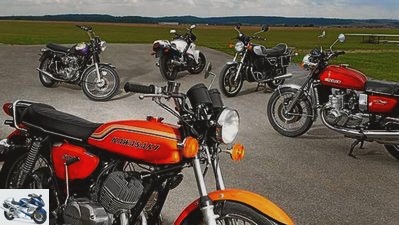
fact
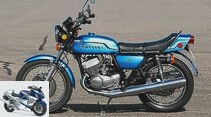


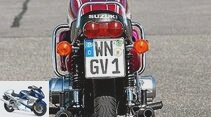
17th pictures

archive
1/17
Kawasaki 750 H2.
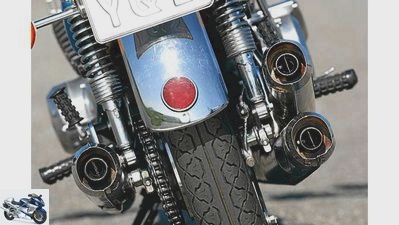
archive
2/17
Most drivers who wanted to take on the 750-H2 looked into the tube, or rather into these tubes.
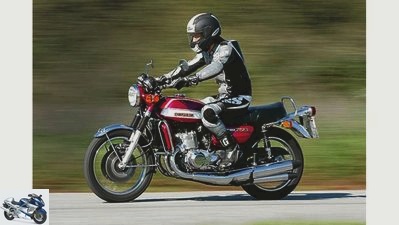
archive
3/17
Suzuki GT 750.
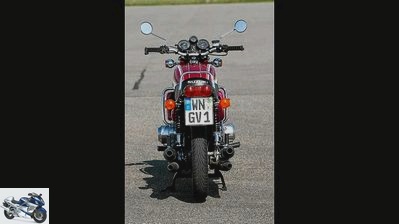
archive
4/17
The four exhausts were typical of the three-cylinder series. The overall width of the engine at the level of the crankshaft can be clearly seen, and the water cooler also shaped the stately appearance.
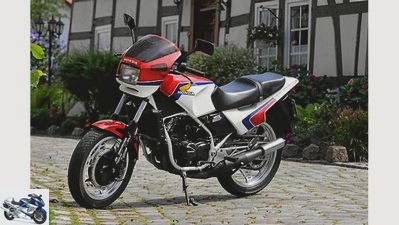
archive
5/17
Honda MVX 250 F..
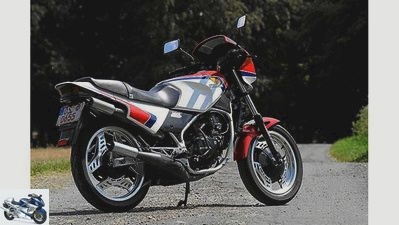
archive
6/17
Sports engine, comfort chassis.
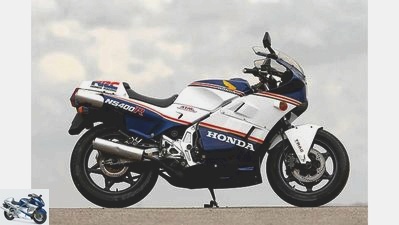
archive
7/17
Honda NS 400 R: The paintwork in Rothmans design pays homage to the British tobacco company, which sponsored the Honda Racing Team from 1985 to 1993.
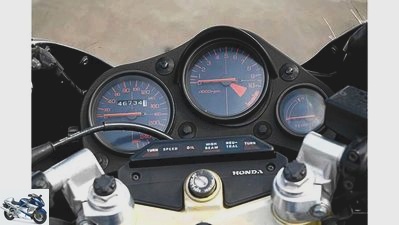
archive
8/17
Tidy cockpit with central tachometer.
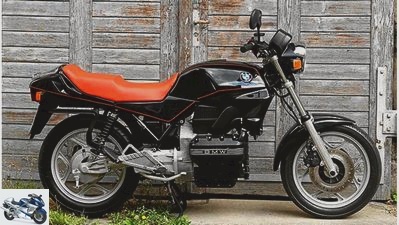
archive
9/17
BMW K 75.
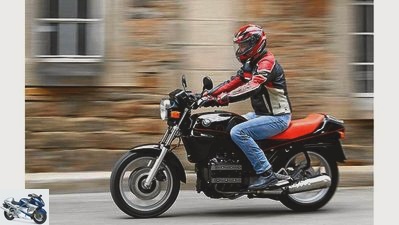
archive
10/17
Classic: upright, relaxed seating position, ideal for long tours.
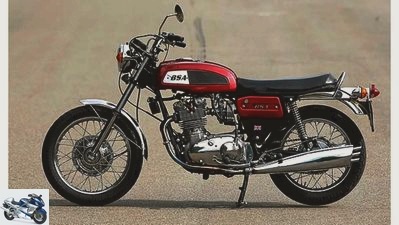
archive
11/17
BSA Rocket 3: The shape of the tank of the first models sparked discussions. The exhaust system with three tailpipes each was characteristic.
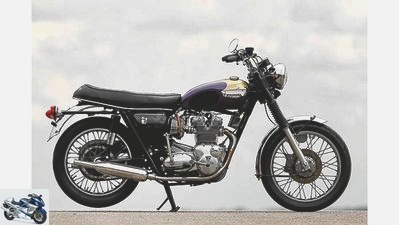
archive
12/17
In mid-1972, Triumph introduced a five-speed transmission to the Trident, and at the end of 1972 it received a disc brake in the front wheel and was called the T 150 V.
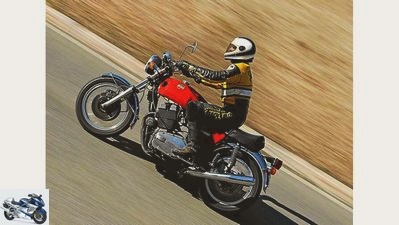
archive
13/17
Laverda 1000 3C.
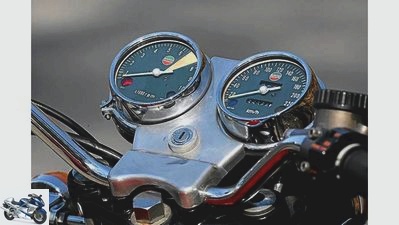
archive
14/17
Instruments by Nippon Denso – the Laverda brothers only bought from the best.
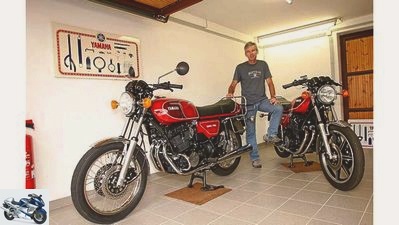
archive
15/17
Yamaha XS 750/850.
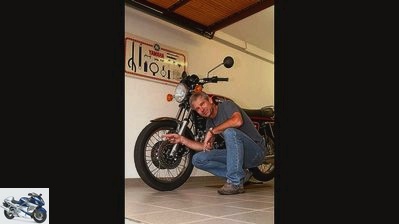
archive
16/17
Rarity: XS 750 with spoked wheels. The conversion once cost 1530 marks.
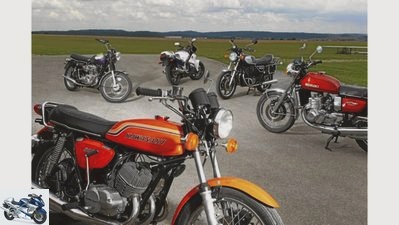
fact
17/17
motorcycles
3 cylinder special – three cylinders from the 70s and 80s
MOTORRAD CLASSIC three-cylinder special
Out and about on the three-cylinder engines of the 1970s and 1980s
Content of
How many cylinders does the motorcyclist need? Whether three or four – emotions play a role in this topic, but so do the differences in technical concepts. MOTORRAD Classic put 14 three-cylinder engines from Kawasaki, Suzuki, Honda, BMW, BSA, Triumph, Laverda and Yamaha under the microscope.
Hans-Jorg Gotzl, Michael Pfeiffer, Fred Siemer, Waldemar Schwarz, Uli Holzwarth, Gerhard Eirich
02/08/2012
What makes the characteristic difference between the three-cylinder and the four-cylinder??
The most striking difference lies first and foremost in the sound, i.e. in the subjective hearing experience. Due to the lower frequency of work cycles and thus ignitions at the same speed, the three-cylinder four-stroke not only sounds duller than the four-cylinder, it also has a completely different timbre. The typical expressions of a three-cylinder in-line engine with a crank pin offset of 120 degrees, i.e. an even firing sequence of 240 degrees for the four-stroke engine, are not dissimilar to the hoarse rattle of a six-cylinder boxer, such as that of a Porsche 911 engine, and are very different from the acoustics of an in-line four-cylinder away. Since three-cylinders are comparatively rare, their sound is perceived subjectively as unusual and characteristic. Of course, this is especially true for two-stroke three-cylinder engines, the sound of which is often compared to that of a turbine.
In contrast to the four-cylinder, which has to struggle with free, i.e. unbalanced, second-order mass forces, the three-cylinder with a 120-degree crankshaft, first-order mass moments cause problems. If the right piston moves upwards, the left one slides downwards, so opposing forces act at the ends of the crankshaft, creating a moment. An effective remedy is a balance shaft rotating at crankshaft speed. Laverda tried to improve the running smoothness with a 180-degree crankshaft – the two outer pistons move up and down synchronously and offset by 180 degrees to the middle piston. This arrangement in turn generates free inertial forces of the second order, which did not give the Laverdas optimal running culture. The technicians from Breganze switched to 120-degree crankshafts for the later models. The three-cylinder two-stroke series from Kawasaki and Suzuki relied on 120-degree crankshafts. The V-triples from Honda were an exception, the crank pin offset of which was based on the cylinder angle.
With regard to the dimensions of three and four-cylinder in-line cylinders with the same displacement, the Triple is clearly narrower, but also slightly higher. When comparing a modern three- and four-cylinder with a stroke / bore ratio of 0.7 and a displacement of 750 cm³, a three-cylinder four-stroke engine is around 60 millimeters narrower and around 10 millimeters higher in the area of the cylinder and cylinder head than the four-cylinder. But due to inconsistent construction, the designers mostly wasted installation space. The only manufacturer who made absolutely consistent use of the advantages of the three-cylinder was MV Agusta with the three-cylinder racing machine that dominated the 350 and 500 world championships from 1966 to 1972. Its engine was incomparably compact compared to the rival 500cc Honda four-cylinder racing machine RC 181, which was reflected in the dimensions of the entire motorcycle and ultimately contributed to its success.
In terms of weight, however, the advantages of the more compact triple compared to the quad are minor if you consider an additional balancer shaft for the three-cylinder, which in-line four-cylinders usually do without.
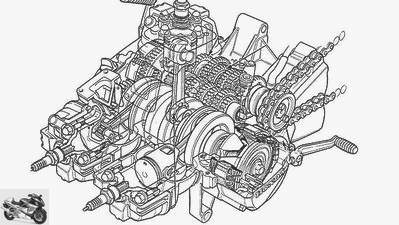
archive
In the three-cylinder V-engine of the Honda NS 400 R, the two horizontal and vertical cylinders form an angle of 90 degrees. The ATAC exhaust control should increase the torque of the two-stroke engine in the lower engine speed range.
Finally, what remains is the power output. In this discipline, the four-cylinder has a slight lead. With the shorter stroke and the lower masses of pistons and connecting rods, it allows higher maximum speeds and thus performance advantages, even if it has higher internal friction losses. MV Agusta also had to recognize this in racing, who switched from three-cylinder to four-cylinder when the Japanese two-stroke competition seemed to be overpowering at the beginning of the 1970s.
Nevertheless, some manufacturers, for example Triumph or Benelli, have specialized in the three-cylinder and have thus acquired a special image. Triumph in particular offers three-cylinders in a wide variety of displacement classes and categories and is therefore successful in the market.
In a final consideration for or against the triplet, subjective sensations such as the inimitable sound play a decisive role. And so an impression that anyone can confirm who has ever driven a three-cylinder, regardless of whether it is two-stroke or four-stroke.
Kawasaki 750/500/400/350/250
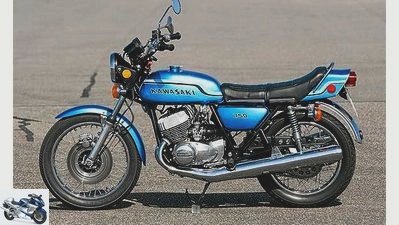
archive
Kawasaki 750 H2.
First of all, the good news: Finally, finally I have one! For two years I’ve been looking for a small Kawasaki 250, preferably an S1 with a cool drum brake. And the day before yesterday it was on the Internet. Near here, her owner wanted to get rid of her. “The little beast is not running properly, and it has been in my way for 20 years …” The man was helped. I took it with me, in blue, totally dirty, rusty, but pretty complete and hardly tinkered with apart from the steering damper.
I’ve been fond of the wild Kawasaki triplets since I was a child. This is due to two things. On the one hand on the spectacular asymmetrical exhaust system with the two pipes on the left and the single one on the right on the chain side. And on the other hand, the wonderfully ribbed cylinders that bulge out of the frame and have a brutal charisma. The rest of the chassis, tank, seat and the thin spoked wheels only serve to somehow bring the whole thing onto the road. These Kawasakis, also called Mach I, II, III and IV, are all MOTORrad. As a result, Kawasaki didn’t care much about brakes. Meager 180 drum brakes should put a stop to the triplets’ fierce forward thrust. That only worked to a limited extent. Later versions had disc brakes throughout. In any case, my S1 can hardly be stopped while pushing it. The brake cable probably consumes most of the hand force through friction. Smells like work, but doesn’t matter.
Thanks to the rather wobbly chassis and the incredibly aggressive power delivery of the first-born, the 500 Mach III, the series quickly lost the image of “widowmaker”. Which of course fueled the greed for the wild Kawas and continues to shape the brand to this day.
My buddy Thomas bought a Mach III back then. After he’d had enough of his Honda CB 500 Four and its smooth engine, and I kept pounding him with the RD 400, it should be the ultimate weapon. It was, at least for ten minutes. The stove went like a beast, liked to click the front wheel in the air and drove Thomas to excellent driving skills. Then came the phase of overheating, with a loud clang the Mach III regularly lost quite a bit of power and put worry lines on Thomas ‘forehead. It was then time to discuss what I had experienced during a cooling-off break and later to examine the scoring on the central piston.
Then in the 90s I bought a green KH 400. It was, so to speak, the gentlest of all the wild sisters. It had 40 hp, a motor in rubber mounts and a disc brake. It barely wobbled and was actually quite well made. Over time, Kawasaki responded with a soothing strategy. The Mach III was throttled down to 50 HP, the 250 to 26 from 28 HP. The wild, 41 hp 350 Mach II replaced by the 400. 350s are extremely rare today in good condition.
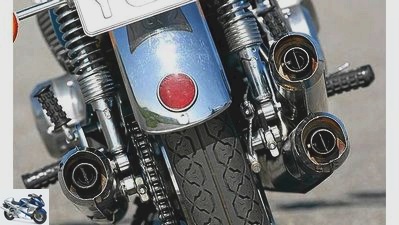
archive
Most drivers who wanted to take on the 750-H2 looked into the tube, or rather into these tubes.
The top model was the 750 H2 Mach IV, released in 1971, with its 71 hp one of the most powerful motorcycles in the world. And that with a dry weight of 192 kilograms and a two-stroke engine. A truly brutal machine at this time and the dream of all men-to-be. In good condition, it fetches the highest prices these days. Scrap changes hands for 4,000 euros, good machines for at least 8,000 euros and new ones for well over 10,000 euros. A lot of money, but the machines, painted in great gold, purple or blue with the sexy hump, still cause a mean crowd today.
I had the grace to tame this beast for a day a few years ago. With today’s experience of engine power, the H2 naturally comes across as rather tame. You have to put the 70 hp in the time. The engine doesn’t seem super snappy these days either, but almost as high-torque. In return, an H2 distributes violent vibrations. The chassis also looks rather good-natured. Equipped with modern tires, such a machine, which used to wobble violently, loses much of its horror and shines with downright great handling and precise cornering. Only the brakes, you have to pay attention to them. Not much is happening there. Added to this is the two-stroke engine, which hardly has any braking effect and makes you really fast before cornering.
Now I’m looking forward to cleaning my (!) New acquisition, the Mach I. And revive them. I will report on it in the next issues. By the way, my former 400 switched to Claus-Peter Elberth, who is certainly not entirely unknown to long-time MOTORRAD Classic readers.
Suzuki GT 750/550/380
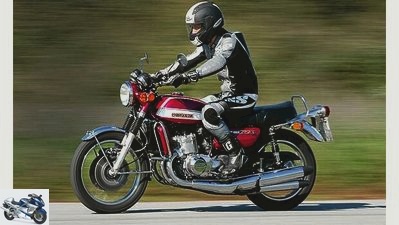
archive
Suzuki GT 750.
I noticed how much material Suzuki was using in its three-cylinder GT series when I was dismantling my 550. The engine needed revision after 70,000 kilometers. But it was real work to lift this dream out of the frame and drag it to the basement workshop. Felt like 60 kilograms for a two-stroke? Why? With the triplets, Suzuki did not focus on top performance, but on smoothness and durability. The crankshaft had quite a flywheel, and the housing with the integrated starter was very big with thick walls. A GT 550 was wider than a CB 500 Four.
But the frame hit the office even more violently than the fat engine. Why Suzuki needed so much metal to build a rather unstable chassis is still a mystery to me today. The frame, swingarm, and fork felt heavier than the engine.
I had bought a ’76 accident GT as a spare parts store. There were often those back then, because the nicely styled Suzukis with their unique three-in-four exhaust systems had rigid footrests and little ground clearance, which tends to pull the front wheel away from one or the other hot spur. My GT, a 73 with the always leaky interference tubes between the manifolds, was converted to the later version. I was also keen on the sensational gear indicator that I actually got to work. And then the second brake disc, a pleasure, but the reason for two front wheel lock falls, because something was wrong with the main brake cylinder.
Basically, the Suzis, especially the 380s that were later sold for 2999 marks, were also very popular, despite the 30 kilograms more weight than their respective Kawasaki counterparts. The GTs looked more valuable, were more dignified and Suzuki visibly focused on durability with the special cooling systems. Ram Air-System was the name of the nicely designed air scoop above the cylinder head of the two air-cooled 380 and 550. It was supposed to capture the cooling air in a targeted manner and guide it through the cooling fins. Suzuki put even more effort into the GT 750: the first water cooling in mass production was used for the top model. Due to the martial appearance with the mighty cooler and the tremendous torque development of the 750s, it quickly got rid of the nickname “water buffalo”.
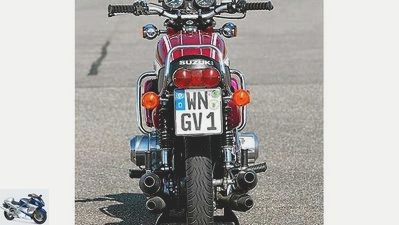
archive
The four exhausts were typical of the three-cylinder series. The overall width of the engine at the level of the crankshaft can be clearly seen, and the water cooler also shaped the stately appearance.
For me, this dream motorcycle was never attainable, my 550 had to be enough. In terms of performance, it was at least equal to the first version with 52 DIN PS of the 750 with the great black end pieces on the exhausts. By the way, the 72 GT 750 J models with drum brakes are already sought-after rarities around the world. But the later versions of the water buffalo with 64 and 67 prospectus horsepower are also in demand. The unique running culture of this fat touring machine, the very special look with the three-in-four exhaust system and the large, polished engine give the GT 750 a special position. Since I was able to restore a buffalo a few years ago in MOTORRAD Classic and then drive it for a few weeks, the driving experiences are still present. That strange floating torque, that barking sound and the thick white cloud during a cold start. Unique in this composition. And I like to remember the many thousands of kilometers with my 550, after all, it carried me halfway around the world.
Honda MVX 250 F.
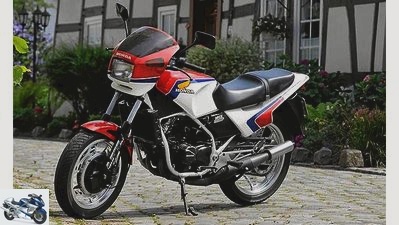
archive
Honda MVX 250 F..
Soichiro Honda was a passionate advocate of the four-stroke, not even its mass-produced vehicle, the Super Cub, was allowed to compete with the simple two-stroke. But already in the desperate battle for the 500 World Cup, he suffered a defeat: A year after the three-cylinder two-stroke NS 500 replaced the oval-piston four-stroke NR 500, the V3 under Freddie Spencer won the long-awaited half-liter title in 1983 . But the markets – especially the domestic one – resisted the will of the great company leader and demanded sporty two-stroke engines.
To Suzuki and Yamaha Not to leave the field without a fight, Honda developed a complete two-stroke family, which celebrated worldwide economic success with 125 single-cylinder engines and produced two icons of the two-stroke cult with the NSR 250 and NS 400 R. But it started with a motorcycle that was primarily intended for Japan and was only exported to a few other countries – in Europe only to Switzerland: the MVX 250 F.
The first “big” Honda two-stroke engine appeared in 1983 and, like a racing machine, drew its power from three cylinders. However, the two outer cylinders are lying, the middle one is. In the case of NS, it’s the other way round. The three Keihin flat slide carburetors sit in the 90-degree V, the intake is controlled by membranes. Unlike Yamaha with the then newly renovated RD, Honda did not have a control system in the exhaust tract. In order to reduce vibrations, the connecting rods and piston pins of the upright cylinder were made significantly more massive than those of the horizontal units.
The water-cooled engine with a six-speed gearbox is located in a double loop frame, which was derived from that of the four-stroke V2 VTR 250. A conventional, air-assisted fork works at the front, a spring strut linked by a lever (Pro Link) at the rear, the front single-disc brake is encapsulated, the light alloy wheels have sheet metal spokes bolted to the hubs and riveted to the rims (Comstar).
At the Osnabruck dealer Wolfgang Fuchs – who specializes in rare goods – MOTORRAD Classic was able to find an MVX 250 and collect surprising impressions. The petite, but by no means super-sporty lighter has an extremely relaxed seating position and a comfortably tuned chassis. The MVX combines superb maneuverability, at least on smooth asphalt, with great steering precision, and it follows its 16-inch front wheel precisely even in fast corners. The somewhat doughy front brake could show greater sportsmanship, but is quite sufficient for fast country road driving.

archive
Sports engine, comfort chassis.
And the engine? It’s just great. Of course, he needs revs to get out of the starting blocks, but the finely adjustable clutch helps. The unexpectedly subtle, yet electrifying sound almost conceals how powerfully this three then gains from 6000 revs, how it develops speed from 7500 rpm and how the tachometer needle – up to the fifth of six optimally graduated gears – reaches the red area at 10500 / min drives. It never looks bony, only vibrates moderately. He reacts spontaneously, but not like an attack, to gas commands, a joy at how easily and precisely the Keihins can be operated. A little gem, typically Honda.
But unfortunately this story also has another side, because the MVX was not taken off the market for nothing after two years. The 40 hp engines were given modified connecting rods for the upright cylinder while the first units were still under warranty. Furthermore, its pistons proved to be not fully gas-proof and were also exchanged. Finally, it turned out that the ignition system, which was incorrectly programmed at the factory, was partly to blame for the burned-out piston. The correction of all these malaises no longer helped the innovative triple. Two years after his death, Honda started a new and much more successful two-stroke attempt with the V2 rocket NSR 250.
Honda NS 400 R.
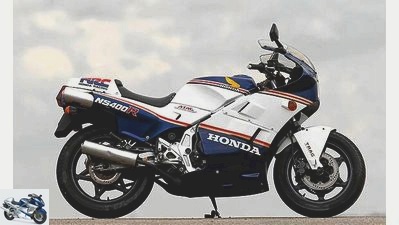
archive
Honda NS 400 R: The paintwork in Rothmans design pays homage to the British tobacco company, which sponsored the Honda Racing Team from 1985 to 1993.
The world champion myth is always there. At least the pilot in the saddle of the NS 400 R feels almost like Freddie Spencer, who was the youngest driver to win the 500cc class in 1983 at the age of 21. Sure, as fast as “Fast Freddie” was certainly never one of the hobby riders in the saddle of the 1985 racing replica. Even in terms of performance, this is an impossibility, as the NSR 500’s racing engine drew an impressive 130 hp from its half-liter capacity. Why didn’t Honda bring the NS 500 R onto the market, as many of the fans had hoped at the time? Almost at the same time as the NS 400 R, Yamaha and Suzuki also launched two-stroke racing replicas, the RD 500 with V4 and 88 hp, the RG 500 with Square Four and 95 hp. The Japanese driving license class of 400 cm³ probably allowed Honda to save development costs and thus prevented the production of a 500 cc offshoot for the world market.
Elsewhere it was not skimpy. For example, weight-saving aluminum was used for both the double loop frame and the swing arm, but the ATAC system (Automatic Torque Amplification Chamber) that promotes the engine and opened a flap in the exhaust ducts of the two horizontal cylinders by means of a servomotor at low speeds was used above all. The ATAC system was omitted for reasons of space for the upright cylinder. Incidentally, the works racer and the production racers available for sale also had three cylinders, but otherwise they had nothing in common with the series. The racing engines had two cylinders in a vertical position and one in a horizontal position.
One or two kicks at most wake the thirsty 400 – it easily consumes eight to ten liters – reliably to life and a unique, hard rattling two-stroke grumbling occurs. It sounds completely different than a Yamaha RD-Twin, a Kawasaki in-line three or a Suzuki RG four. The Honda never wins the sound rating, but the NS 400 R can convince in all other disciplines. The sitting posture is typical for Honda: take a seat and feel good. Fits for small drivers as well as for tall guys, and today the racer with its comfortable design with the relatively high handlebar stubs and the relaxed knee angle is more likely to be considered a sports tourer. Starting off is possible with a bit of feeling even without speed orgies, although the first gear is long enough to reach over 80 km / h. For civil everyday strolling there is enough power even in the lower speed range. However, it only really goes ahead from 6000 rpm. End of town, second gear, full throttle – this is how two-stroke bite should feel. Shifting at 10,000 rpm, third, fourth, the gears engage easily and precisely. In the sixth, according to the factory, with a lot of run-up, 215 km / h would be possible. The imaginary home straight that has just been taken with 150 items ends abruptly at the next place-name sign, which fast-forward 28 years and brings the driver who dreams of 1983 back into the present.
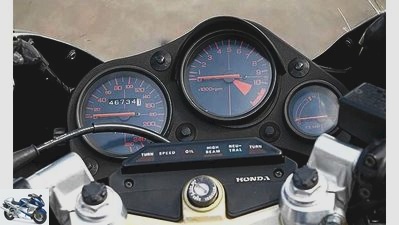
archive
Tidy cockpit with central tachometer.
When braking, the NSR driver experiences just as little nasty surprises as he does in brisk bends thanks to the Nissin double-piston system, which can be precisely and accurately metered even for today’s demands. 192 kg with a full tank is not record-breaking light, but the 400er, rolling on a narrow 16-inch wheel at the front, steers light-footed and precisely and behaves pleasantly neutral. Setting up in an inclined position is almost unfamiliar to the 400, and straight-line stability is always flawless. By the way: The Triple was only used for two seasons in the Honda works team. In 1984 the Japanese used a V4. 1985 Spencer became world champion again. In addition to the 500, also in the 250 class. Quite almost, this Freddie.
BMW K 75
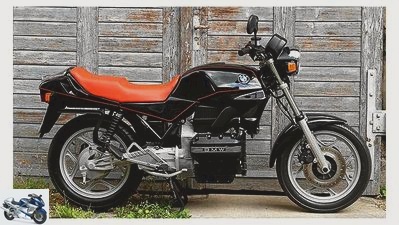
archive
BMW K 75.
What a bit of make-up can do: Discreet chrome jewelry here, polished dip tubes there and some blush on the seat and the black paintwork – that was enough in 1987 to transform the BMW K 75 from a pale wallflower into a naked beauty. Which still attracts attention today. Because it is relatively rare. And it doesn’t look like a gap filler at all.
An image that the Bayern three-man, built from 1985 to 1996, could never shake off in this country. Settled between the boxers and the expensive K 100 models in terms of price and performance, the special feature of the K 75, its harmonious three-cylinder, was a little lost. Well, on the emotional side there are more beguiling three-cylinders than the Bavarian triple. Instead of the characteristic hissing and roaring, the high-frequency whistling of the straight-toothed primary drive dominates here. In addition, the threesome seems a little inhibited when turning out. However, he makes up for a lack of passion with his beefy character. Great, how the three-cylinder marches powerfully just above idle, accelerates extremely gently and – thanks to the counter-rotating balance shaft – runs almost vibration-free up to 6500 tours.
In addition, the harmony bolt has a robust nature. The drive and cardan hardly cause any serious problems, even at higher mileages. Calm natures and kilometer eaters get their money’s worth with the K 75. Especially tall people, for whom the classic sitting position on instead of in a motorcycle enables a fatigue-free position. But the BMW doesn’t deter smaller pilots either. Your driving behavior is devoid of pitfalls, if not particularly agile – 236 kilos just require a bit of emphasis in tight radii. Like all older BMWs without Paralever, the K 75 prefers a round driving style in order to keep the up and down of the cardan within limits. Once you have aimed at it, the K circles astonishingly fast through the maze of curves, whereby the good passage saves many shifting maneuvers in the clumsy five-speed gearbox.
If you are looking for a problem-free three-cylinder with the best all-round qualities, you can confidently shortlist a K 75 – regardless of whether it is with or without make-up.
BSA Rocket 3 / Triumph Trident

archive
BSA Rocket 3: The shape of the tank of the first models sparked discussions. The exhaust system with three tailpipes each was characteristic.
In the 1960s, British two-cylinder engines like the Triumph Bonneville slowly reached their performance limits. Above all, the spoiled US clientele demanded stronger motorcycles. The Triumph designers Bert Hopwood and Doug Hele had a simple concept in mind. Instead of a completely new design, the tried and tested 500 series twins, like a Tiger, could simply be expanded to include a further cylinder unit to form a triple, which would result in a displacement of 750 cm³. But the final design with a 67 mm bore and 70 mm stroke was, in contrast to the Tiger engine, ultimately designed with a slightly long stroke. When it leaked from Japan in the mid-1960s that Honda would develop a four-cylinder with 750 cc, the British made nails when it comes to three-cylinder. A prototype of the engine was built under high pressure in twelve months, which was based on the ohv two-cylinder design with the two camshafts in front of and behind the cylinders and the valve actuation by means of bumpers and rocker arms. Only the power transmission with a triple roller chain as the primary drive and a dry clutch differed from the Twins. The relocation of the exhaust system was unusual. The middle exhaust manifold split and opened into one of the two outer ones.
Triumph had developed the three-cylinder in the Meriden plant to the point where it was ready for series production, but at that time it was already part of the BSA Group and so the BSA emblem ultimately adorned the tank of another motorcycle with three-cylinder. However, despite the fact that as many identical parts as possible are desired due to synergy effects, the BSA visually differ from the Triumph.
In contrast to the Triumph’s cylinders standing vertically on the engine case, those of the BSA tilted slightly forward, which required completely new engine cases. The engine innards, however, were largely identical. The frames also presented themselves differently. The Trident relied on a single-loop frame with split beams, the Rocket 3 on a double loop frame.
DAS MOTORRAD presented both triplets in the spring of 1968, but in contrast to American customers, the European clientele had to wait another year. DAS MOTORRAD completed its first test in the spring of 1969 and came to the conclusion: “The two motorcycle models of the 750 series generate enthusiasm through the unheard-of speed they are, through the technical peculiarities of the three-cylinder engine and its running characteristics, through the English Motorcycle tradition that is by no means hiding. ”
Despite the delay in delivery, the two three-cylinder units were on the market in good time before the Honda CB 750 appeared. From a technical point of view, it was clearly ahead with its ohc four-cylinder, electric starter, disc brake in the front wheel and with 67 to 58 hp and raised the bar in the luxury class.
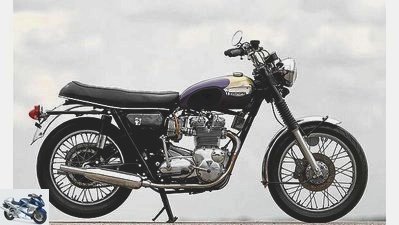
archive
In mid-1972, Triumph introduced a five-speed transmission to the Trident, and at the end of 1972 it received a disc brake in the front wheel and was called the T 150 V.
But even if the BSA / Triumph triplets looked a bit old-fashioned technically and optically against the Honda, they should still be present in the market for a while. And that although the economic conditions were not exactly favorable for the survival of the two brands. The BSA group was struggling with serious financial problems. In April 1973 the last Rocket 3 rolled off the line and the Trident production also stopped for the time being, as all triples were made at BSA. Additional delays brought a workers strike and the occupation of the Triumph plant before the Trident could continue to be built. At the end of 1975 Triumph ceased production of the T 160, now with an electric starter. Today these facts are history, what counts is the character. And without a doubt, both of them have that to offer.
The seating position is very British. With an upright torso, hands loosely placed on the broad handlebars, feet wide and far forward on the footrests and with a relaxed knee angle, the British woman sits enthroned as if at the Queen’s birthday dinner.
Once it has been laboriously brought to life with a kick starter and warmed up, the three-cylinder is able to please when it comes out of the basement of revs. From increased idle speed, it pushes vehemently. Thanks to its characteristics, the three-of-a-kind leaves a confident impression on the country road. From 5000 rpm, however, the thrust decreases noticeably. It is the switch foot’s turn, namely the right one. The four courses want to be changed emphatically, short and crisp. Shifting is also called for because of the vibrations, which are limited up to 5000 rpm, but increase sharply with increasing speed and can wear down people and material, as a full gas test on the motorway from Hamburg to Vienna showed. Contrary to the expectations of the MOTORRAD editors, the engine withstood the ordeal without complaint, but had caused several vibration cracks in the add-on parts.
The sound offers no cause for criticism: In the lower speed range, the engine babbles to itself, and with increasing speed goes into deep roaring to a dull howling sound, as only a three-cylinder four-stroke with 120 degree crank pin offset celebrates. This sound alone can be addicting one after the other. Despite the slack suspension struts, the chassis is reasonably stable and feels relatively handy behind the wide handlebars thanks to the moderate weight of 223 kilograms.
Compared to the Honda CB 750, the triples from BSA and Triumph look like cruisers. Take a comfortable seat, step through the aisles, let yourself be carried by the torque wave and enjoy the wonderful sound – pure relaxation sets in as if by itself.
Laverda 1000 3C
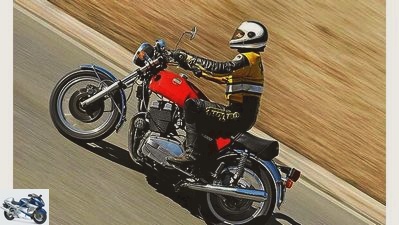
archive
Laverda 1000 3C.
There are motorbikes that you drive by chance. They run towards you somehow, and because they prove their worth and don’t bother, they just stay there. That much is clear, nobody drives a Laverda by mistake – especially not the sinister three-cylinder with the unusual 180-degree crankshaft.
When idling, this engine sounds like a washing machine with bearing damage – or like an in-line four-cylinder that someone has stolen a spark plug connector. What the Laverda Triple is basically: While the middle piston is in the bottom dead center, the two outer pistons are at the top and ignite again offset by one revolution. This is called a flat or 180-degree crankshaft, and Laverda chief technician Luciano Zen in Breganze in northern Italy wanted to avoid the destructive fine vibrations of the 120-degree crankshaft otherwise common in three-cylinder engines.
As a bonus, the test bench certified that the 180-degree three-cylinder had significantly more pressure in the lower speed range than a 120-series engine. The price for this is the rumbling sound in idle, pithy but not unpleasant vibrations – and under full load a roar that is not reminiscent of a tamed 911, as is usual with a three-cylinder, but rather of a Ferrari racing car from the 50s. And not find friends everywhere.
In any case, I was thrilled when I saw a 1000 Laverda live and in color for the first time in the flail years. Waiting at a traffic light with the moped, suddenly a damn big and damn red motorcycle appeared next to me, making a hell of a noise. And the driver in his scarred French Furygan station wagon looked darn daring.
Of course, I knew all the test reports from MOTORRAD, especially Franz-Josef Schermer’s summary after the long-term test in 1975: “A good man on a 1000cc Laverda – that can be an optimal combination for well over 25,000 kilometers.” They were completely over the moon English and American colleagues, especially from the even sharper Jota version, and outdid each other with martial formulations. Tasting: “A Laverda only makes sense if you have the concentration and the self-confidence to remember the old days when you were a torpedo rider – or a Stuka pilot.”
Such sentences only fuel the desire, but Laverda is not for sale on every corner: Although the 1000 series was for a short time the fastest production motorcycle in the world, won its first race before production started and was referred to as the Lamborghini on two wheels, a high level of vertical integration prevented , an astronomical price and probably also the disturbing sound a wider distribution.

archive
Instruments by Nippon Denso – the Laverda brothers only bought from the best.
Around 6000 three-cylinders in all variants are said to have been built, the version I was looking for with Borrani high-shoulder rims, Brembo double disc brakes and oil cooler was hardly installed 1000 times in 1975. In any case, I had the right leather suit well in advance.
At some point I found my copy, but it still required work. But I had long since learned that you don’t buy a Laverda when you need it, but when you find a useful one. Since then, the three-cylinder has thrilled me with this unique sound, the powerful acceleration from 3000 tours and the feeling of mechanical indestructibility with every trip. The Laverda is stable even in very fast corners, the Brembos still decelerate very well and you can still very easily lose your driving license with this motorcycle.
Well, the right-hand shift is sometimes noticeable, the three-cylinder needs a fresh 20 W 50 every 3000 kilometers due to the lack of an oil filter, and the beast from Breganze not only eats rear but also front tires. Chains anyway, a new set of primary chains was just due. But what a tester put it in the seventies still applies: “No matter what they do with you out there in the daily jungle, you know that you can sit on the Laverda in the evening and run away. And no price is too high for this type of therapy. “
Yamaha XS 750/850
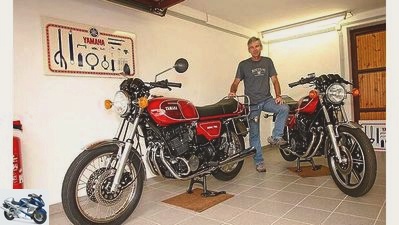
archive
Yamaha XS 750/850.
There are garages that make motorcycle enthusiasts’ hearts open. Not because sinfully expensive treasures are parked in it. But because you can feel that someone here has devoted himself to his hobby.
Ekkehard Lemke is one of those people who doesn’t do things by halves with his bikes. For over 30 years he has been cherishing, indeed living his childhood dream, the XS three-cylinder from Yamaha. The 53-year-old has archived all test reports on the 750 and 850 XS models in thick files, as well as all the original brochures, workshop manuals and operating instructions. And of course he also has the rare XS 750 poster from 1977. Or the blackboard for the XS special tool.
The fact that the XS 750 is not exactly a popular collector’s model with a guaranteed increase in value does not challenge the Swabian: “I am simply fascinated by the wonderful three-cylinder sound of the XS 750, that sonorous rumble when strolling around that turns into a hoarse rumble as soon as you give the triple the spurs. ”Goosebumps pleasure, which was not always unclouded, however. Because of all things Lemke’s first XS 750, which he had painstakingly saved up as a 21-year-old military service provider, caused some bitter disappointment. Already on the first day the XS, a 1978 demonstration model with just 70 kilometers on the clock, refused to work – battery flat. The next day the rear wheel blocked shortly before the home garage: Deflection gear and final drive had eaten – logical if the cardan oil is missing. The repair took an endless six weeks, then the acid defaced the ruptured battery rear and muffler. “But when the XS 750 was running, it was great,” says Lemke, recalling his tours through Corsica, Greece, Italy or France with pillion passenger and luggage. After 41,000 kilometers in two years, an engine overhaul (incorrectly installed piston rings) and another sharp increase in oil consumption, he had enough and switched to a BMW R 100 S..
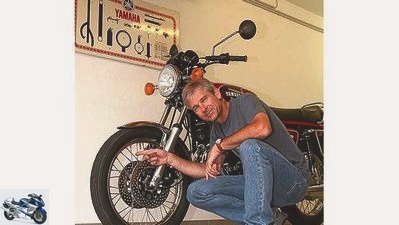
archive
Rarity: XS 750 with spoked wheels. The conversion once cost 1530 marks.
But the temporarily faint three-cylinder fire flares up again: A 77-XS is followed by the 850, for Lemke “the most sophisticated and best three-cylinder”. But he just likes the harmonious appearance of the 750 with its deep exhaust system better. In 1998 he ended up with the 1979 model of the XS 750, which he still owns today. You can recognize it by the beefy 24-liter tank. And on the rare spoked wheel conversion by a Bremen specialist who takes the classic appearance to the extreme. In 2003 things came full circle: In Belgium, Lemke came across an XS 750 from 1978. The training model for Yamaha service technicians with chassis number 0001 had only run 800 kilometers at the time. With the new tank and paint kit in red, the external condition now also matches the mileage of 1300 kilometers.
Who can he recommend the XS 750 to? Lemke doesn’t think twice: “Everyone who is looking for a well-balanced tourer. And of course everyone who has their heart pounded by this three-cylinder sound. “
Classified ads of used motorcycles from the 70s and 80s
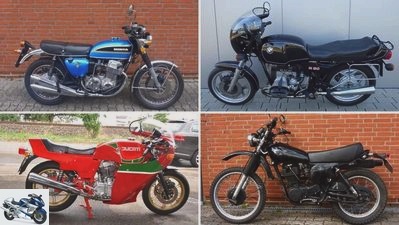
1000PS marketplace app
The variety of used classic cars is enormous.
Motorcycle classics encircles a large scene, which means good news on the used market for classic car enthusiasts. You can find numerous motorcycles from the 70s and 80s in every imaginable condition. From rusty project bikes to fully restored museum pieces, everything is represented on the motorcycle market. Here is an overview of used motorcycles from the 70s and 80s: used motorcycles from the 70s and 80s in Germany.
Related articles
-
Motorcycles with three cylinders at a glance
jkuenstle.de 9 pictures gold & Goose 1/9 Current three-cylinder: Triumph Speed Triple. jkuenstle.de 2/9 Current three-cylinder: Triumph Daytona 675….
-
Annette Johann to travel Alpine special Alpine special Three weeks at the top Either over 1800 meters high or under three meters wide ?? nothing in…
-
motorcycles ABS special ABS special The state of affairs Today only a few incorrigible people are still discussing the point of ABS in motorcycles. The…
-
archive to travel Photo special for travel Photo special for travel Take better photos The road to a good travel photo doesn’t have to be rocky. If you…
-
Bilski motorcycles Middle class special Middle class special China Middle class ?? the term has something disrespectful to some. All he says is that…
-
Motorcycling under special conditions
Rosen Gargolov 12th pictures MOTORCYCLE 1/12 The measured values of a Honda CBR 600 F show how different road surfaces in the rain affect the braking…
-
MOTORCYCLE pre-owned special 2018
MOTORCYCLE, Arnold Debus, Emanuele Bella, KTM, Yamaha Sports & scene MOTORCYCLE pre-owned special 2018 MOTORCYCLE pre-owned special 2018 Order now with…
-
Buy used – rare motorcycles and special models
Breakable 24 pictures Breakable 1/24 Alejandro Garcia, Neuss, Yamaha R6 Rossi Edition, EZ 6/2005, 14,100 km, 5,290 euros: the classy 600 is very well…
-
Out and about: Michael Martin Special
Michael Martin 53 pictures Martin 1/53 Of course, that makes Indian men curious. Martin 2/53 … on the most beautiful slopes in the world. Martin 3/53…
-
Cylinder piston connecting rod
fact 15th pictures 1/15 The conventional connecting rod, on the other hand, is machined in several steps and fixed with a fit. The two connecting rod…